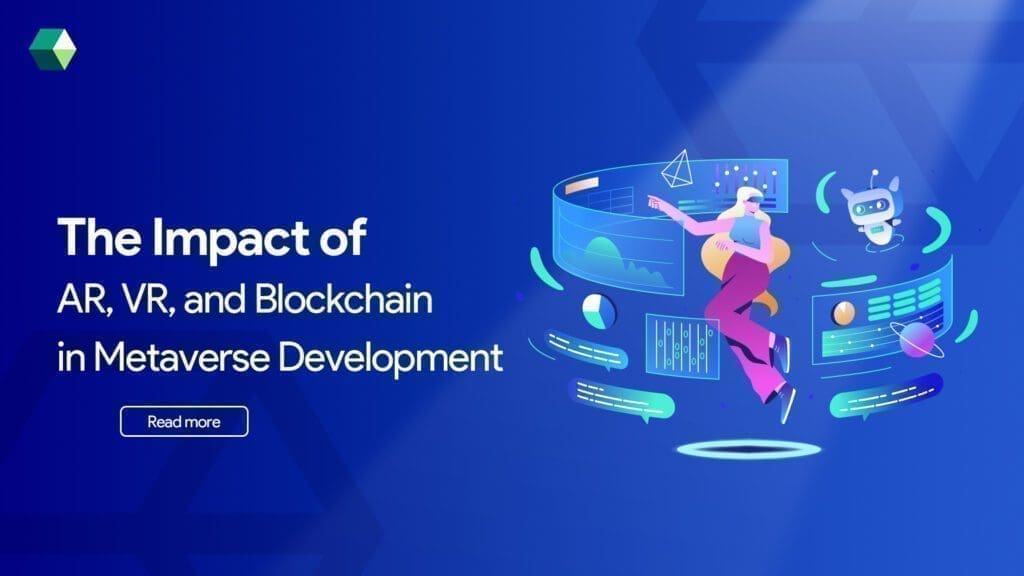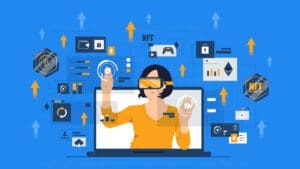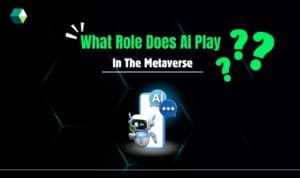
The concept of the metaverse—a shared, immersive digital universe—has moved beyond science fiction and into mainstream technology. But what truly powers this next-gen virtual world isn’t just 3D graphics or immersive headsets—it’s blockchain technology. In traditional online platforms, users have limited control over their digital assets, identities, and data. Blockchain changes that by introducing decentralization, transparency, and digital ownership. It acts as the backbone of the metaverse, enabling secure transactions, tokenized economies, and user-owned ecosystems.
As more businesses and developers jump into metaverse platform, blockchain has become essential in creating open, trustless, and persistent virtual environments. From virtual real estate and digital wearables to NFT marketplaces and in-game currencies, blockchain ensures that everything in the metaverse is verifiable, tradable, and secure. We’ll explore how AR (Augmented Reality), VR (Virtual Reality), and blockchain together are revolutionizing the metaverse—and why this matters more than ever today.
What is the Metaverse and Why Does it Matter?
The metaverse is a collective virtual shared space, created by the convergence of virtually enhanced physical environments and persistent virtual spaces. Simply put, it’s a digital universe where people can create avatars, interact with others, attend events, purchase digital goods, and much more.
But why does the metaverse matter? Simply put, it’s redefining how we connect, work, and experience the digital world. Unlike traditional social media platforms, the metaverse offers more immersive and interactive environments where people can engage in real-time using avatars and 3D spaces. Beyond social interaction, it opens up vast business opportunities across industries like virtual real estate, gaming, digital fashion, and online entertainment.
Sectors such as education, healthcare, and remote work are also being transformed with immersive, engaging virtual experiences. As tech giants continue to invest heavily and user interest grows rapidly, metaverse platform development is quickly becoming one of the most exciting and impactful trends in today’s digital landscape.
How Augmented Reality (AR) Enhances the Metaverse Experience
Augmented Reality overlays digital content onto the real world using smartphones, tablets, or smart glasses. In the metaverse, AR acts as a bridge between physical and digital environments, enabling users to interact with 3D elements while still rooted in their real-world surroundings.
Augmented Reality (AR) plays a crucial role in enhancing the metaverse experience by seamlessly blending digital elements with the real world. One of its key contributions is enabling users to interact with digital avatars or virtual objects within their physical environments, creating more engaging and lifelike experiences. In the realm of gaming and entertainment, AR has already proven its potential through popular titles like Pokémon Go, and within the metaverse, this level of interaction is elevated to new heights.
The retail industry is also embracing AR by offering virtual try-on features and immersive digital showrooms, allowing users to explore products in a more personalized way. Overall, AR adds a powerful layer of realism to metaverse platform development services, making the experience more dynamic, interactive, and accessible—even for users who may not have access to full VR equipment.
Virtual Reality (VR) – Taking Immersion to the Next Level
While AR enhances reality, Virtual Reality completely immerses users in a digital environment. VR headsets transport users to entirely new worlds — from fantasy lands to digital offices.
Virtual Reality (VR) is a driving force behind the immersive nature of the metaverse, offering users the ability to fully step into digital environments. It enables complete immersion, allowing people to attend virtual concerts, explore interactive games, or participate in lifelike virtual meetings as if they were physically present. One of VR’s biggest strengths is enhancing social interaction through motion tracking and spatial audio, which creates more natural and intuitive communication between users.
In education and professional training, VR opens up new possibilities—from medical simulations to virtual classrooms—making learning more hands-on and impactful. For any metaverse platforms, creating rich and immersive VR environments is essential to delivering engaging, realistic experiences that keep users coming back.
Blockchain – The Backbone of a Decentralized Metaverse
One of the most essential pillars of the metaverse is blockchain technology. It provides the foundation for decentralization, security, and true digital ownership in virtual environments. Through blockchain, users can own digital assets—such as land, avatar clothing, and collectibles—thanks to NFTs (non-fungible tokens), which ensure that ownership is unique, verifiable, and transferable. Decentralization is another key benefit, as blockchain removes the need for a central authority, making the metaverse more open, transparent, and democratic.
Additionally, blockchain enables secure and tamper-proof transactions, which are vital for maintaining trust in virtual economies. With robust blockchain metaverse platform, users gain the freedom to trade assets, participate in decentralized governance, and even generate real-world income from their activities within the metaverse.
The Synergy of AR, VR, and Blockchain in Metaverse Platform
Each of these technologies—AR, VR, and blockchain—offers powerful capabilities on its own. But when combined, they unlock the full potential of the metaverse. Augmented Reality (AR) and Virtual Reality (VR) together create rich, mixed-reality environments where users can move fluidly between the physical and digital worlds. Pairing VR with blockchain enables real economies within virtual spaces, where assets like land, currencies, and collectibles are tokenized and tradable.
Meanwhile, integrating AR with blockchain allows for secure identity verification, ownership of digital overlays, and tracking of real-world interactions. When a metaverse platform development brings all three technologies together, the result is a dynamic, decentralized ecosystem where experiences are not only immersive but also secure, user-owned, and highly valuable
Real-World Applications and Use Cases
Let’s look at how these technologies are already being used in practical metaverse scenarios:
-
Gaming
Games like Decentraland and The Sandbox offer user-generated virtual worlds powered by blockchain. Players can buy land, build experiences, and trade assets using NFTs.
-
Virtual Real Estate
Metaverse real estate is booming. Digital plots of land are being bought and sold using blockchain, allowing users to build businesses, host events, or invest in virtual property.
-
Fashion and Retail
Brands like Gucci and Nike are launching virtual stores and digital wearables. Customers can try on clothes using AR and buy exclusive digital products as NFTs.
-
Education
Virtual classrooms powered by VR and blockchain offer immersive learning, student credential verification, and global accessibility.
-
Healthcare
From VR surgeries to AR-enabled diagnostics, healthcare professionals are using the metaverse to train, collaborate, and improve patient outcomes.
These real-world applications are proof that the metaverse is more than hype — it’s a transformative shift in how we live and work.
The Future of the Metaverse- What’s Next?
The metaverse is still in its early stages, but its future looks incredibly promising. Here are a few trends to watch:
-
AI Integration
Artificial Intelligence will power smarter NPCs, personalized user experiences, and automated support in the metaverse. From lifelike virtual characters to intelligent shopping assistants, AI will make interactions more dynamic and tailored.
-
Cross-Metaverse Interoperability
Users will soon move their avatars, NFTs, and assets across multiple platforms seamlessly. Interoperability will be key to building a connected, user-centric metaverse ecosystem.
-
More Wearables
Brands like Gucci and Nike are launching virtual stores and digital wearables. Customers can try on clothes using AR and buy exclusive digital products as NFTs.
-
Greater Decentralization
Decentralized Autonomous Organizations (DAOs) will give users governance power over virtual worlds. This shift will create more transparent, community-driven metaverse platforms aligned with Web3 values.
As a forward-looking immersive technology company, staying ahead of these trends is crucial to building future-ready platforms.
Why You Should Pay Attention Now
The convergence of AR, VR, and blockchain is not just a technological trend — it’s a revolution. These technologies are reshaping how we engage with the internet, creating opportunities for businesses, developers, and individuals alike. If you’re a brand, startup, or enterprise, investing in metaverse platform development services can help you stay ahead of the curve. From virtual storefronts to immersive events, the possibilities are endless. And for users, the metaverse offers a new way to connect, explore, learn, and even earn.
Ready to Explore the Metaverse? Here’s What to Do Next
The metaverse is no longer just a futuristic vision—it’s a rapidly growing digital reality with massive potential for early movers. Whether you’re an entrepreneur, brand, developer, or investor, now is the ideal time to dive in. Start by learning how AR, VR, and blockchain are shaping this new era of digital interaction. Define your specific goals—be it launching a virtual game, creating an NFT-based marketplace, or building an immersive decentralized platform.
Choosing the right metaverse solutions provider is key to turning your vision into reality. Nadcab Labs, a leader in blockchain metaverse platform, offers comprehensive solutions including AR/VR integration, smart contract, NFT platforms, and custom virtual ecosystems. Our team brings deep expertise in blockchain and Web3 technologies, helping you build secure, scalable, and future-ready metaverse experiences. Take the first step into the future—partner with Nadcab Labs and start your metaverse journey today.







